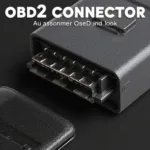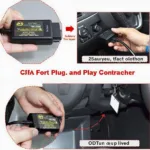The OBD2 P2122 code, indicating a problem with the throttle/pedal position sensor/switch “E” circuit, can be a frustrating issue for car owners. This article provides a comprehensive guide to understanding, diagnosing, and resolving the P2122 code, helping you get back on the road quickly and safely.
What is the OBD2 P2122 Code?
The P2122 diagnostic trouble code (DTC) specifically points to a low input problem in the throttle/pedal position sensor/switch “E” circuit. This sensor, often called the TPS or PPS, is critical for your vehicle’s engine management system. It tells the engine control unit (ECU) how far the accelerator pedal is depressed, allowing it to adjust the throttle opening and fuel delivery accordingly. A low input signal means the ECU is receiving a voltage reading lower than expected, which can cause various driveability issues.
Symptoms of a P2122 Code
A P2122 code can manifest in various ways, affecting your driving experience and potentially causing damage if left unaddressed. Here are some common symptoms:
- Check Engine Light: The most obvious sign is the illumination of the check engine light on your dashboard.
- Reduced Engine Power: You may notice a decrease in acceleration and overall engine performance. This can feel like the car is lacking power or hesitating.
- Limp Mode: In some cases, the vehicle might enter a “limp mode” to protect the engine from further damage. This severely limits engine power and speed.
- Rough Idle: The engine might idle erratically or stall altogether.
- Poor Fuel Economy: A malfunctioning TPS can lead to inefficient fuel consumption.
Causes of a P2122 Code
Several issues can trigger the P2122 code. Pinpointing the exact cause requires careful diagnosis. Common culprits include:
- Faulty Throttle/Pedal Position Sensor: The sensor itself may be worn, damaged, or malfunctioning due to age or exposure to the elements.
- Wiring Problems: Damaged, corroded, or loose wiring in the sensor circuit can disrupt the signal.
- Connector Issues: A loose or damaged connector at the sensor can prevent proper communication with the ECU.
- Carbon Buildup: Carbon buildup on the throttle body can interfere with the sensor’s operation.
- ECU Problems: Although less common, a faulty ECU can also be the source of the problem.
How to Diagnose a P2122 Code
Diagnosing a P2122 code involves a systematic approach. Here’s a step-by-step guide:
- Retrieve the Code: Use an OBD2 scanner to read the stored trouble codes. Confirm the presence of the P2122 code.
- Inspect the Wiring and Connector: Visually check the wiring harness and connector for any signs of damage, corrosion, or looseness.
- Test the TPS: Use a multimeter to check the sensor’s voltage output and resistance. Compare the readings to the manufacturer’s specifications.
- Clean the Throttle Body: Carefully clean the throttle body to remove any carbon buildup that may be affecting the sensor.
How to Fix a P2122 Code
The solution to a P2122 code depends on the underlying cause. Here are some common fixes:
- Replace the TPS: If the sensor is faulty, replacement is often the most straightforward solution.
- Repair or Replace Wiring: Damaged or corroded wiring should be repaired or replaced as needed.
- Clean or Replace the Connector: A dirty or damaged connector should be cleaned or replaced.
- Clean the Throttle Body: Thoroughly cleaning the throttle body can resolve issues related to carbon buildup.
- ECU Reprogramming or Replacement: In rare cases, the ECU may require reprogramming or replacement.
Conclusion
The OBD2 P2122 code, while potentially troublesome, can be diagnosed and resolved with the right approach. By understanding the code, its symptoms, and potential causes, you can take the necessary steps to fix the issue and restore your vehicle’s performance. Regular maintenance and prompt attention to warning signs can help prevent future occurrences of the P2122 code.
FAQ
- Can I drive with a P2122 code? While you might be able to drive, it’s not recommended. The reduced engine power and potential for limp mode can create dangerous driving situations.
- How much does it cost to fix a P2122 code? The cost varies depending on the cause and the necessary repairs. A new TPS can range from $50 to $200, while labor costs can add to the total.
- Can a bad battery cause a P2122 code? While a failing battery can cause various electrical issues, it’s unlikely to directly cause a P2122 code.
- Is the P2122 code serious? It can be. Ignoring the code can lead to further damage and more costly repairs.
- How can I prevent a P2122 code? Regular maintenance, including cleaning the throttle body and inspecting wiring, can help prevent this code.
Need help? Contact us via WhatsApp: +1(641)206-8880, Email: [email protected] or visit us at 789 Elm Street, San Francisco, CA 94102, USA. We have a 24/7 customer support team.

